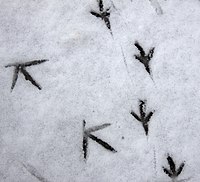Animal track
imprint left behind in soil, snow, or mud, or on some other ground surface, by an animal walking across it
An animal track is the imprint left behind in soil, snow, mud, or other ground surfaces that an animal walks across.


Animal tracks are used by hunters to track their prey, and by naturalists to identify animals living in an area.[1][2]
Tracks can be fossilized over millions of years.[3] It is for this reason we are able to see fossilized dinosaur tracks in some types of rock formations. These types of fossils are called trace fossils since they are a trace of an animal left behind rather than the animal itself. In paleontology, tracks often preserve as sandstone infill, forming a natural mold of the track.[4]
Related pages
changeReferences
change- ↑ Staff. "Animal tracks: what do they reveal?". Smithsonian National Zoological Park. Retrieved April 7, 2016.
- ↑ Evans, Jonah (2014). "Field guides to animal tracks". NatureTracking.com. Retrieved April 7, 2016.
- ↑ Vitkus, Allison; Chin, Karen; Lockley, Martin. "Fossil footprints through geologic time". University of California Museum of Paleontology. Retrieved April 7, 2016.
- ↑ "A three-dimensionally preserved sauropod manus impression from the Upper Jurassic of Portugal: implications for sauropod manus shape and locomotor mechanics". Kaupia. 14: 47–52. Retrieved March 2, 2014.
{{cite journal}}: Unknown parameter|authors=ignored (help)